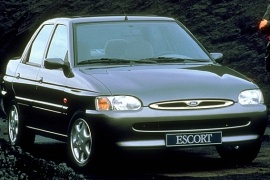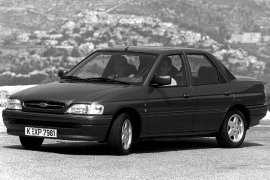FORD Escort 4 Doors Models/Series Timeline, Specifications & Photos
First production year: 1993
Engines: Gasoline, Diesel
The fifth generation of the Escort knew several facelifts, including the 1995 model, which some named as the sixth generation.
If someone could spot the differences between a 1993 and a 1995 Escort, that person should be chosen for a competition of “spot the 10 differences between these two images”. There were thin lines between the two facelifted models, and it was just a way for Ford to buy some time before the launch of the new compact-sized vehicle, the Focus, which arrived just three years later.
The new, oval-shaped grille and the headlights were replaced, like in most cases of facelifted models. The trend started to go toward round shapes, and Ford was happy since its badge was oval. For the four-door version, the carmaker already gave up the Orion name, which helped the car be well marketed.
The most significant differences were inside, where Ford introduced a completely new dashboard with improved materials and shapes. Its instrument cluster featured arched lines instead of the bulky form of its predecessor. Depending on the trim level, an oval-shaped clock was placed next to the steering wheel, while the center stack sported the HVAC units and the stereo-cassette sound system.
Depending on the market and trim level, the Escort sedan featured a choice of seven engines ranged between 60 hp and 105 hp. One of the most important improvements was the new, 1.8-liter turbodiesel engine that offered an excellent fuel-efficiency.
Also known as the Orion, the Escort sedan was refreshed in 1993, together with the rest of the range.
The 1993 model-year had to be improved to comply with the new European emissions pollutions that came into force in 1994. Ford considered that it was a good time to refresh the exterior's look.
The Escort featured a mixed design, between the boxy-looking vehicles of the '80s and the flowing lines of the '90s. For the facelifted range, the grille featured black, slim, horizontal slats. The headlights and the turn-signals were in separate blocks and covered with clear glass. For the rest of the car, the lines remained similar, but an enhancement was made for the door handles, which were in body color, unlike the non-facelift version where they were black. In the back, the taillights were mounted only on the quarter panels.
Ford answered some criticisms and redesigned the dashboard, which now featured the center stack and the upper area modified. As for the instrument cluster, a new set of dials was installed, but offering the same information as on the non-facelifted version. For selected versions, an airbag was fitted as standard. The customers considered the four-door version a family sedan with a slight appeal for the middle-class buyers and the car-rental services as well.
Under the hood, Ford offered a choice of six engines, including two diesel versions. The base version was a frugal 1.3-liter unit that offered only 60 hp, while the top-performer version was the 1.8-liter engine with 108 hp. All versions were paired to a 5-speed manual gearbox.

